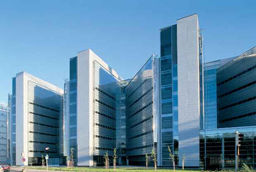Are you just getting started in developing a comprehensive storage, backup or disaster recovery plan? Here you will find information on our technologies and technical terms.
RAID – Redundant Array of Inexpensive Disks – is a method of combining several hard drives into one logical unit. It can offer fault tolerance and higher throughput levels than a single hard drive or group of independent hard drives. RAID is a mature technology that speeds up data access while at the same time protecting your data from hard disk failure. RAID is quickly becoming a necessary component in every network since data loss and downtime can prove both fatal and financially destructive. Most networks are designed to provide instant access to massive amounts of data. More and more employees have to access customer and other databases. Intranets and corporate Web sites provide access to huge databases online. RAID provides increased storage capacities, and protects your important data from hard drive failure.
RAID Levels:
There are multiple benefits of using RAID:
- Reliability
- Scalability
- Real-time data recovery with uninterrupted access when a hard drive fails
- System uptime and network availability
- Protection against data loss
- Multiple drives working in parallel increase system performance
A disk system with RAID capability can protect its data and provide on-line, immediate access to its data, despite a single disk failure (some RAID storage systems can withstand two concurrent disk failures). RAID capability also provides for the on-line reconstruction of the contents of a failed disk to a replacement disk.
RAID offers faster hard drive performance and nearly complete data safety. Storage requirements are expanding as file sizes get bigger and rendering needs get more complex. If you handle very large images or work on audio and video files, faster data throughput means enhanced productivity. RAID can be backed up to tape while the system is in use.
Software RAID vs. Hardware RAID
NT offers native support for software-based redundant arrays of inexpensive disks (RAID). RAID is a drive configuration that uses multiple drives to provide higher speed and greater data protection than a single drive. NT can combine multiple independent drives into a RAID configuration through its disk subsystem components. In other words, NT performs all of the complicated disk read and write activities necessary to create RAID sets. This is known as software-based RAID. It has the advantage of being cheap, because it is built into Windows NT. However, it is minimally useful as a performance improvement tactic. NT provides RAID from software by using the CPU and other system resources to process disk reads and writes. For systems with minimal disk access, performance is improved; however, for systems with significant disk access, performance is severely degraded.
Hardware RAID devices are specialty drive devices that host multiple drives external to the computer system. Hardware RAID devices manage all of the disk reads and writes independent of the operating system. This provides several benefits, including true high-performance disk access. Hardware RAID does not tax the CPU or other system resources because a hardware RAID device requires no more processing power than a standard disk drive. In fact, the OS is typically unaware that the disk device is RAID hardware. The only drawback to hardware RAID is the cost. A RAID device typically costs two to ten times as much as a comparable non-RAID drive (or set of drives).
Background
There are 5 most commonly used RAID levels. These levels are not ratings, but rather classifications of functionality. Different RAID levels offer dramatic differences in performance, data availability and data integrity depending on the specific I/O environment. There is no single RAID level that is perfect for all users.
RAID 0: Striping
RAID 0 refers to striping data across multiple disks without any redundant information. Data is divided into blocks and distributed sequentially among the disks. This level is also referred to as pure striping. The number of disk drives needed to create a RAID 0 is one or more. In other words, a single drive can be configured as a RAID 0 array. This type of array can be used to enhance performance in either a request rate intensive or transfer rate intensive environment. Unfortunately, striping reduces the level of data availability since a disk failure will cause the entire array to be inaccessible.
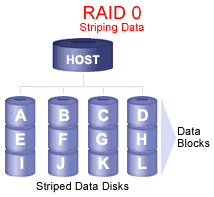

RAID 0 was not defined originally but has become a commonly used term.
Advantages:
- Easy to Implement
- No capacity loss – all storage is usable
Disadvantages:
- Not a “true” RAID due to the lack of fault-tolerance
- Failure of only one disk will result in loss of all data on the array
RAID 1: Mirroring / Duplexing
RAID 1 is the first defined level that allows a measure of data redundancy. Data written to one disk drive is simultaneously written to another disk drive. If one disk fails, the other disk can be used to run the system and reconstruct the failed disk. Since the disk is mirrored, it does not matter if one of them fails because both disks contain the same data at all times.
RAID level 1 provides high data availability since two complete copies of all information are maintained. In addition, read performance may be enhanced if the array controller allows simultaneous reads from both members of a mirrored pair. Higher availability will be achieved if both disks in a mirror pair are on separate I/O busses, known as duplexing


- Higher read performance than a single disk
Disadvantages:
- Requires twice the desired disk space
RAID 3: Striping & Parity
In RAID 3, data is striped across a set of disks. In addition, parity is generated and stored on a dedicated disk. With RAID 3, data chunks are much smaller than the average I/O size and the disk spindles are synchronized to enhance throughput in transfer rate intensive environments. RAID 3 is well suited for CAD/CAM or imaging type applications as well as streaming media. Since parity is used, a RAID 3 stripe set can withstand a single disk failure without losing data or access to data.
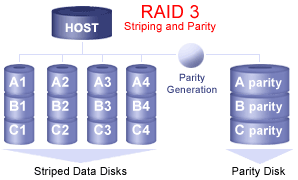

Advantages:
- Good data availability
- High performance for transfer rate intensive applications
- Cost effective – only 1 extra disk is required for parity
Disadvantages:
- Poor random I/O performance
- Disk failure has a significant impact on performance
RAID 5: Striping & Parity
RAID 5 similar to level-3, stripes data and parity to generate redundancy. However, instead of requiring entirely new disk for parity storage, the parity is distributed through the stripe of the disk array.
In RAID 5 both parity and data are striped across a set of separate disks. Next, the new parity is calculated. Finally, the new data and parity are written to separate disks. Data chunks are much larger than the average I/O size, but are still resizable. Disks are able to satisfy requests independently which provides high read performance in a request rate intensive environment. Since parity information is used, a RAID 5 stripe can withstand a single disk failure without losing data or access to data.
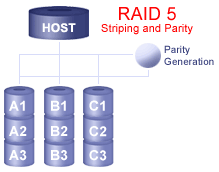

- Highest read data transaction rates
- Cost effective – only 1 extra disk is required
Disadvantages:
- Individual block data transfer rate same as a single disk
RAID 10
RAID 10 is technically (RAID 1 + RAID 0), a combination of RAID 1 and 0 – mirroring and striping, but without parity. RAID 10 is a stripe across a number of mirrored drives. It is implemented as a striped array whose segments are RAID 1 arrays. RAID 10 has the same fault tolerance as RAID level 1, as well as the same overhead for fault-tolerance as mirroring alone.
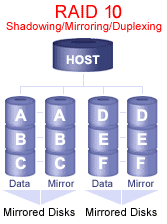

- Very high I/O rates are achieved by striping RAID 1 segments
- Excellent solution for sites that would normally use RAID 1
- Great for Oracle and other databases which need high performance and fault tolerance
Disadvantages:
- Expensive to maintain
- As with RAID 1 total capacity is equal to half of the total capacity of all disk in the array
DNF Security
DNF Security is a subsidiary of Dynamic Network Factory headquartered in the heart of Sillicon Valley, CA.
©2020 Dynamic Network Factory
Follow us
